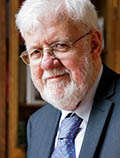David O’Connor, Anthropology
 David Bourke O’Connor, a former professor of ancient Egyptian history and archaeology and former curator of the Egyptian collection of the Penn Museum, passed away on October 1 in Bala Cynwyd, Pennsylvania after a long illness. He was 84.
David Bourke O’Connor, a former professor of ancient Egyptian history and archaeology and former curator of the Egyptian collection of the Penn Museum, passed away on October 1 in Bala Cynwyd, Pennsylvania after a long illness. He was 84.
Born in Sydney, Australia, Dr. O’Connor received his BA in Cypriote and near eastern archaeology in 1958 from the University of Sydney. He then took up study in the U.K., earning a post-graduate diploma in Egyptology from University College London (where he was the Lady Wallis Budge Fellow) in 1962. Afterwards, he split his time between England and the U.S. He came to Penn in 1964, taking both staff and faculty positions. That year, he began serving as an assistant curator-in-charge of the Egyptian section of the Penn Museum, and as an instructor in Egyptology in Penn’s department of oriental studies (a precursor to, among others, today’s department of near eastern languages and civilizations). Meanwhile, he worked toward a PhD in Egyptology from the University of Cambridge, which he received in 1969. The next year, Penn promoted him to an assistant professor in Egyptology, and in 1974, he became an associate professor.
In 1969, Dr. O’Connor was also promoted to associate curator-in-charge of the Egyptian section of the Penn Museum, and in 1990 he became curator-in-charge. During this stint, he curated and co-curated several substantial in-house or traveling exhibits (covering the art and archaeology of Abydos, women in ancient Egypt, and ancient Nubia). Under the auspices of the Penn Museum, he directed excavations at Abydos and co-directed excavations at the palace-city and gigantic harbor of Amenhotep III at Malkata, western Thebes. In 1982-1983, he received a Guggenheim Fellowship, with which he researched urbanism in ancient Egypt, particularly the royal city. His profile elevated by this prestigious work, Dr. O’Connor accumulated responsibility at Penn, serving as research coordinator for curatorial and research sections of the Penn Museum beginning in 1983. From 1980 to 1982, he served as the department of oriental studies’ graduate group chair and associate department chair, and in 1990 he became a full professor. He was a longtime member of Penn’s University Council, and in 1994, he chaired its bookstore committee.
Dr. O’Connor left Penn in 1995 (taking curator emeritus status at the Penn Museum) and accepted a position as the Lila Acheson Wallace Professor of Ancient Egyptian Art at the Institute of Fine Arts of New York University. He was an active faculty member at NYU, serving on the Institute of Fine Arts’ advisory committee and holding the position of deputy director for faculty and administration since 2010. Outside of Penn and NYU, Dr. O’Connor was an active scholar, serving as president of the Oriental Club of Philadelphia and of the American Research Center in Egypt. In 1985, he received a Medal of Merit from Taiwan’s National Museum of History in recognition of the cultural value of a Penn Museum exhibit he had curated. He wrote and co-wrote several books about ancient Egypt, including Ancient Egypt: A Social History (1983); Ancient Nubia: Egypt’s Rival in Africa (1993); and Abydos: Egypt’s Earliest Pharaohs and the Cult of Osiris (2009).
He is survived by his wife, Gulbun O’Connor, former associate ombudsman at Penn; his daughters, Katherine O’Connor, CAS ’96, and Aisha O’Connor, CAS ’93; and three grandchildren.
